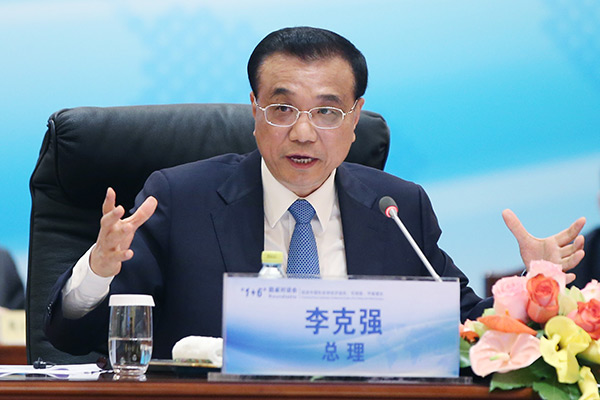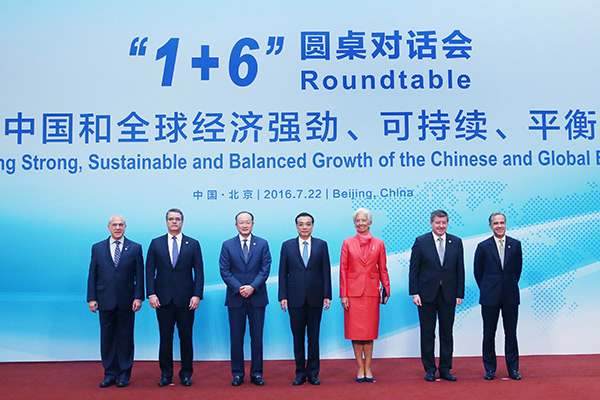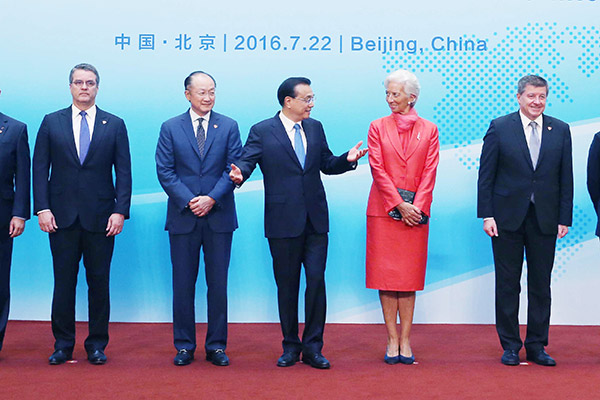
Premier Li Keqiang holds a “1+6” roundtable meeting with global financial leaders, including World Bank Group President Jim Yong Kim, International Monetary Fund Managing Director Christine Lagarde, World Trade Organization Director-General Roberto Azevedo, International Labor Organization Director-General Guy Ryder, Organization for Economic Cooperation and Development Secretary-General Angel Gurria and Financial Stability Board Chairman Mark Carney in Beijing, on July 22, 2016. He discusses the new growth engines in China’s economic transformation with the six international financial chiefs. [Photo/Xinhua]
Premier Li Keqiang on July 22 had a deep discussion about the new driving forces in China’s economic transition in Session II of the “1+6” roundtable meeting at Fanghua Villa, Diaoyutai State Guesthouse in Beijing.
The participants are World Bank Group President Jim Yong Kim, IMF Managing Director Christine Lagarde, WTO Director-General Roberto Azevedo, ILO Director-General Guy Ryder, OECD Secretary-General Angel Gurria and FSB Chairman Mark Carney.

Premier Li Keqiang holds a “1+6” roundtable meeting with global financial leaders, including World Bank Group President Jim Yong Kim, International Monetary Fund Managing Director Christine Lagarde, World Trade Organization Director-General Roberto Azevedo, International Labor Organization Director-General Guy Ryder, Organization for Economic Cooperation and Development Secretary-General Angel Gurria and Financial Stability Board Chairman Mark Carney in Beijing, on July 22, 2016. He discusses the new growth engines in China’s economic transformation with the six international financial chiefs. [Photo/Xinhua]
Premier Li outlined the current state of China’s economy. He said that facing the many tough challenges at home and abroad as well as downward economic pressure, the Chinese government has managed to sustain steady economic growth and accelerate economic transformation. Efforts were made to keep the direction of macroeconomic policy stable, focusing on structural reform - that on the supply side in particular, and to grow the new economy and foster new drivers of growth while upgrading traditional ones. China has remained one of the fastest growing major economies, and made good gains in upgrading its economic structure. In the past three years, the service sector as a share of GDP rose by 8.6 percentage points and the contribution of final consumption to GDP growth was up by 16.9 percentage points. Fast development of the new economy has helped to transform and revitalize the traditional industries and strongly boosted employment. Over 13 million urban jobs were created on an average annual basis in the past three years.

Premier Li Keqiang holds a “1+6” roundtable meeting with global financial leaders, including World Bank Group President Jim Yong Kim, International Monetary Fund Managing Director Christine Lagarde, World Trade Organization Director-General Roberto Azevedo, International Labor Organization Director-General Guy Ryder, Organization for Economic Cooperation and Development Secretary-General Angel Gurria and Financial Stability Board Chairman Mark Carney in Beijing, on July 22, 2016. He discusses the new growth engines in China’s economic transformation with the six international financial chiefs. [Photo/Xinhua]
He said that China’s economy has maintained steady performance and made positive advances. The new drivers of growth are rising, traditional drivers of growth are adapting, and the overall economy is undergoing a structural shift. All these have been made possible by reform and innovation. The Chinese government has made tremendous efforts to streamline administration, delegate power, enhance regulation where necessary, and provide better services. Thanks to the strategy of innovation-driven development, mass entrepreneurship and mass innovation are booming, and new forms of business, including economy based on crowd business and crowd innovation and sharing economy, are thriving. All these are what underpin China’s economic growth, structural transition and upgrading and job creation. We will fully leverage China’s human capital advantage, advance the new type of urbanization and deepen all-round reform and opening-up to bolster the new sources of growth. China welcomes the ideas and suggestions on its economic development, especially ways to create and upgrade the sources of growth and transform the economic structure.
Premier Li stressed that China will maintain the continuity, stability and focus of its macroeconomic policy, continue to pursue a proactive fiscal policy and a prudent monetary policy, enhance discretionary macro-regulation and undertake preemptive adjustment and fine-tuning as the changing dynamics require. China will expand aggregate demand as appropriate, focus on supply-side structural reform and take multi-pronged steps to bring down the leverage ratio of non-financial enterprises in an active yet prudent manner. While addressing overcapacity, China will take measures to protect the rights and interests of employees and help them get re-employed by boosting mass entrepreneurship and innovation. China now enjoys steady economic performance, a surplus in its international balance of payments, ample foreign exchange reserves and a sturdy fiscal and financial system. There is no basis for continuous depreciation of the RMB. China will stay on the course of market-oriented reform of the exchange rate, give greater play to the decisive role of the market, and keep RMB exchange rate basically stable at an adaptable and equilibrium level.
Leaders of the international economic and financial institutions said that China’s measures of structural reform prove to be productive, and growth has become more resilient and sustainable. The prophecy of China’s economy heading for a “hard landing” is rarely heard now. China’s investment in human capital and innovation is impressive, its emerging industries such as e-commerce and e-finance are at the forefront in the world, and new economy and new drivers of growth face enormous opportunities for further development. International economic and financial institutions are ready to enhance coordination and cooperation with China, and support China in its efforts to advance reform and opening-up, improve social security system and forestall financial risks.
